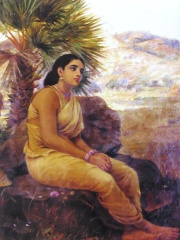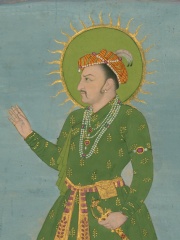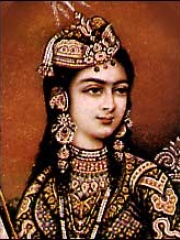COMPANION
Sita

 Sita
Sita
Sita (Sanskrit: सीता; IAST: Sītā), also known as Siya, Jānaki and Maithili, is a Hindu goddess and the female protagonist of the Hindu epic Ramayana. Sita is the consort of Rama, the avatar of god Vishnu, and is regarded as an avatar of goddess Lakshmi. She is the chief goddess of the Ramanandi Sampradaya and is the goddess of beauty and devotion. Sita's birthday is celebrated every year on the occasion of Sita Navami. Read more on Wikipedia
Her biography is available in 63 different languages on Wikipedia (up from 62 in 2024). Sita is the 143rd most popular companion (down from 76th in 2024), the 85th most popular biography from India (down from 41st in 2019) and the 3rd most popular Indian Companion.
Sita is most famous for being the wife of Lord Rama in the Hindu epic Ramayana.
Memorability Metrics
Page views of Sita by language
Among COMPANIONS
Among companions, Sita ranks 143 out of 784. Before her are Soraya Esfandiary-Bakhtiary, Catherine of Austria, Queen of Portugal, Rosalynn Carter, Louise of Hesse-Kassel, Elena of Montenegro, and Constance of Aragon. After her are Gala Dalí, Caroline of Baden, Princess Sophie of Hohenberg, Alexandra Feodorovna, Maria Anna of Neuburg, and Anne of Foix-Candale.
Most Popular Companions in Wikipedia
Go to all RankingsSoraya Esfandiary-Bakhtiary
1932 - 2001
HPI: 72.31
Rank: 137
Catherine of Austria, Queen of Portugal
1507 - 1578
HPI: 72.27
Rank: 138
Rosalynn Carter
1927 - 2023
HPI: 72.27
Rank: 139
Louise of Hesse-Kassel
1817 - 1898
HPI: 72.25
Rank: 140
Elena of Montenegro
1871 - 1952
HPI: 72.19
Rank: 141
Constance of Aragon
1179 - 1222
HPI: 72.17
Rank: 142
Sita
HPI: 72.17
Rank: 143
Gala Dalí
1894 - 1982
HPI: 72.16
Rank: 144
Caroline of Baden
1776 - 1841
HPI: 72.14
Rank: 145
Princess Sophie of Hohenberg
1901 - 1990
HPI: 72.14
Rank: 146
Alexandra Feodorovna
1798 - 1860
HPI: 72.06
Rank: 147
Maria Anna of Neuburg
1667 - 1740
HPI: 72.05
Rank: 148
Anne of Foix-Candale
1484 - 1506
HPI: 72.01
Rank: 149
In India
Among people born in India, Sita ranks 85 out of 1,861. Before her are Zubin Mehta (1936), Dara Shukoh (1615), Vishwanath Pratap Singh (1931), Shivaji (1627), Jahanara Begum (1614), and Muhammad bin Tughluq (1290). After her are Julie Christie (1940), B. D. Jatti (1912), Mohammed Nadir Shah (1883), Jahangir (1569), William Makepeace Thackeray (1811), and Priyanka Chopra (1982).
Others born in India
Go to all RankingsZubin Mehta
CONDUCTOR
1936 - Present
HPI: 73.09
Rank: 79
Dara Shukoh
POLITICIAN
1615 - 1659
HPI: 72.89
Rank: 80
Vishwanath Pratap Singh
POLITICIAN
1931 - 2008
HPI: 72.82
Rank: 81
Shivaji
POLITICIAN
1627 - 1680
HPI: 72.81
Rank: 82
Jahanara Begum
POLITICIAN
1614 - 1681
HPI: 72.45
Rank: 83
Muhammad bin Tughluq
POLITICIAN
1290 - 1351
HPI: 72.37
Rank: 84
Sita
COMPANION
HPI: 72.17
Rank: 85
Julie Christie
ACTOR
1940 - Present
HPI: 72.12
Rank: 86
B. D. Jatti
POLITICIAN
1912 - 2002
HPI: 72.08
Rank: 87
Mohammed Nadir Shah
POLITICIAN
1883 - 1933
HPI: 71.80
Rank: 88
Jahangir
POLITICIAN
1569 - 1627
HPI: 71.76
Rank: 89
William Makepeace Thackeray
WRITER
1811 - 1863
HPI: 71.73
Rank: 90
Priyanka Chopra
ACTOR
1982 - Present
HPI: 71.72
Rank: 91
Among COMPANIONS In India
Among companions born in India, Sita ranks 3. Before her are Mumtaz Mahal (1593), and Mariam-uz-Zamani (1542). After her are Jagat Gosain (1573), Mastani (1699), Brian Horrocks (1895), Salima Sultan Begum (1539), and Kashibai (1703).
Mumtaz Mahal
1593 - 1631
HPI: 85.84
Rank: 1
Mariam-uz-Zamani
1542 - 1623
HPI: 73.82
Rank: 2
Sita
HPI: 72.17
Rank: 3
Jagat Gosain
1573 - 1619
HPI: 63.83
Rank: 4
Mastani
1699 - 1740
HPI: 58.26
Rank: 5
Brian Horrocks
1895 - 1985
HPI: 56.76
Rank: 6
Salima Sultan Begum
1539 - 1613
HPI: 56.21
Rank: 7
Kashibai
1703 - 1758
HPI: 52.57
Rank: 8































